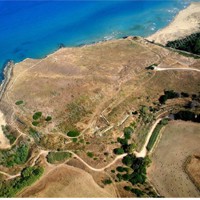Eloro is an archaeological site situated on a hill overlooking the Ionian Sea, near the town of Noto near Syracuse, at the mouth of the river Tellaro (then with the same name of the city).
History
The city was founded by the Corinthians in the seventh century BC, the director of the later "via Elorina, which connects the Greek colonies of Syracuse and Gela Kamarina. Tellaro upper course of the river, near the city of Hippocrates, tyrant of Gela, defeated in battle in 493 BC Syracusan forces, while in the course of the Peloponnesian War the Athenians were defeated in 413 BC In 263 BC it was part of the possessions recognized by Romans Hieron II of Syracuse in 213 BC It was then conquered by the Romans, led by Consul Claudius Marcellus in 214 BC the city was flourishing during the Byzantine era, but was almost completely destroyed with the arrival of the Arabs.
Buildings
The city walls, dating from the fifth century BC Paolo Orsi and subsequently assigned instead to the sixth century BC in their original phase. Following were rebuilt on the ruins of older ones, perhaps in the second half of the fourth century BC In the south-east of a medieval tower ("Tower Stampace") was built in 1353 by Blasco Alagona, the orders of Peter of Aragon to the defense of the coast, the tower stands on the remains of a fortress, mentioned by Pliny the Elder in the first century AD
The most important sanctuary was on the outside of the wall: it was dedicated to Demeter and Kore, and perhaps takes a more ancient religion indigenous Sicilian. It was on the outside of the walls and consisted of different environments. The first facility dates from the sixth century BC, but was used until the third century BC, as evidenced by the votive offerings in the Archeological Museum of Noto. Subsequently, the shrine was relocated within the city as a small temple in antis, and surrounded by a colonnade (stoa) in three arms, in Doric facade and two aisles.
The arcade was also connected with the agora, which remains visible only rock-cut cisterns to collect rainwater. From square one he walked away towards the sea to the south-east, together with another street in a north-south axes of the defined urban structure of the city.
A shrine dedicated to the god Asclepius (Asklepios in greek and-Aesculapius Aesculapius in Latin), the fourth century BC, consists of a courtyard surrounded by porticoes, where the sick and slept stopped pending the visit of the god in a dream that would lead to healing. Nearby stood a small Thesauros, which is a building shaped like a small temple in antis will host the votive offerings and dated to the late fourth century.
To the south, on the slopes of the hill, there is a greek theater, partly dug into the rock and partly built, from the end of IV - beginning of III century BC, partly affected by a drainage canal running in the thirties.
Northwest was the "Column pizzuta, a funerary monument, consisting of a huge limestone column drums (diameter of 3.80 m and reconstructed in about 10 m). Nearby is an excavated in the rock, dating from the second half of the third century BC saw in the ruins of Paolo Orsi in 1899 and the tank. The four city cemeteries (as distinct from modern scholars with the first letters of the alphabet) were situated on the terrace north of the rock.
Nature Reserve Vendicari
The site borders the nature reserve Vendicari, with golden sand dunes and clear waters.
History
The city was founded by the Corinthians in the seventh century BC, the director of the later "via Elorina, which connects the Greek colonies of Syracuse and Gela Kamarina. Tellaro upper course of the river, near the city of Hippocrates, tyrant of Gela, defeated in battle in 493 BC Syracusan forces, while in the course of the Peloponnesian War the Athenians were defeated in 413 BC In 263 BC it was part of the possessions recognized by Romans Hieron II of Syracuse in 213 BC It was then conquered by the Romans, led by Consul Claudius Marcellus in 214 BC the city was flourishing during the Byzantine era, but was almost completely destroyed with the arrival of the Arabs.
Buildings
The city walls, dating from the fifth century BC Paolo Orsi and subsequently assigned instead to the sixth century BC in their original phase. Following were rebuilt on the ruins of older ones, perhaps in the second half of the fourth century BC In the south-east of a medieval tower ("Tower Stampace") was built in 1353 by Blasco Alagona, the orders of Peter of Aragon to the defense of the coast, the tower stands on the remains of a fortress, mentioned by Pliny the Elder in the first century AD
The most important sanctuary was on the outside of the wall: it was dedicated to Demeter and Kore, and perhaps takes a more ancient religion indigenous Sicilian. It was on the outside of the walls and consisted of different environments. The first facility dates from the sixth century BC, but was used until the third century BC, as evidenced by the votive offerings in the Archeological Museum of Noto. Subsequently, the shrine was relocated within the city as a small temple in antis, and surrounded by a colonnade (stoa) in three arms, in Doric facade and two aisles.
The arcade was also connected with the agora, which remains visible only rock-cut cisterns to collect rainwater. From square one he walked away towards the sea to the south-east, together with another street in a north-south axes of the defined urban structure of the city.
A shrine dedicated to the god Asclepius (Asklepios in greek and-Aesculapius Aesculapius in Latin), the fourth century BC, consists of a courtyard surrounded by porticoes, where the sick and slept stopped pending the visit of the god in a dream that would lead to healing. Nearby stood a small Thesauros, which is a building shaped like a small temple in antis will host the votive offerings and dated to the late fourth century.
To the south, on the slopes of the hill, there is a greek theater, partly dug into the rock and partly built, from the end of IV - beginning of III century BC, partly affected by a drainage canal running in the thirties.
Northwest was the "Column pizzuta, a funerary monument, consisting of a huge limestone column drums (diameter of 3.80 m and reconstructed in about 10 m). Nearby is an excavated in the rock, dating from the second half of the third century BC saw in the ruins of Paolo Orsi in 1899 and the tank. The four city cemeteries (as distinct from modern scholars with the first letters of the alphabet) were situated on the terrace north of the rock.
Nature Reserve Vendicari
The site borders the nature reserve Vendicari, with golden sand dunes and clear waters.



